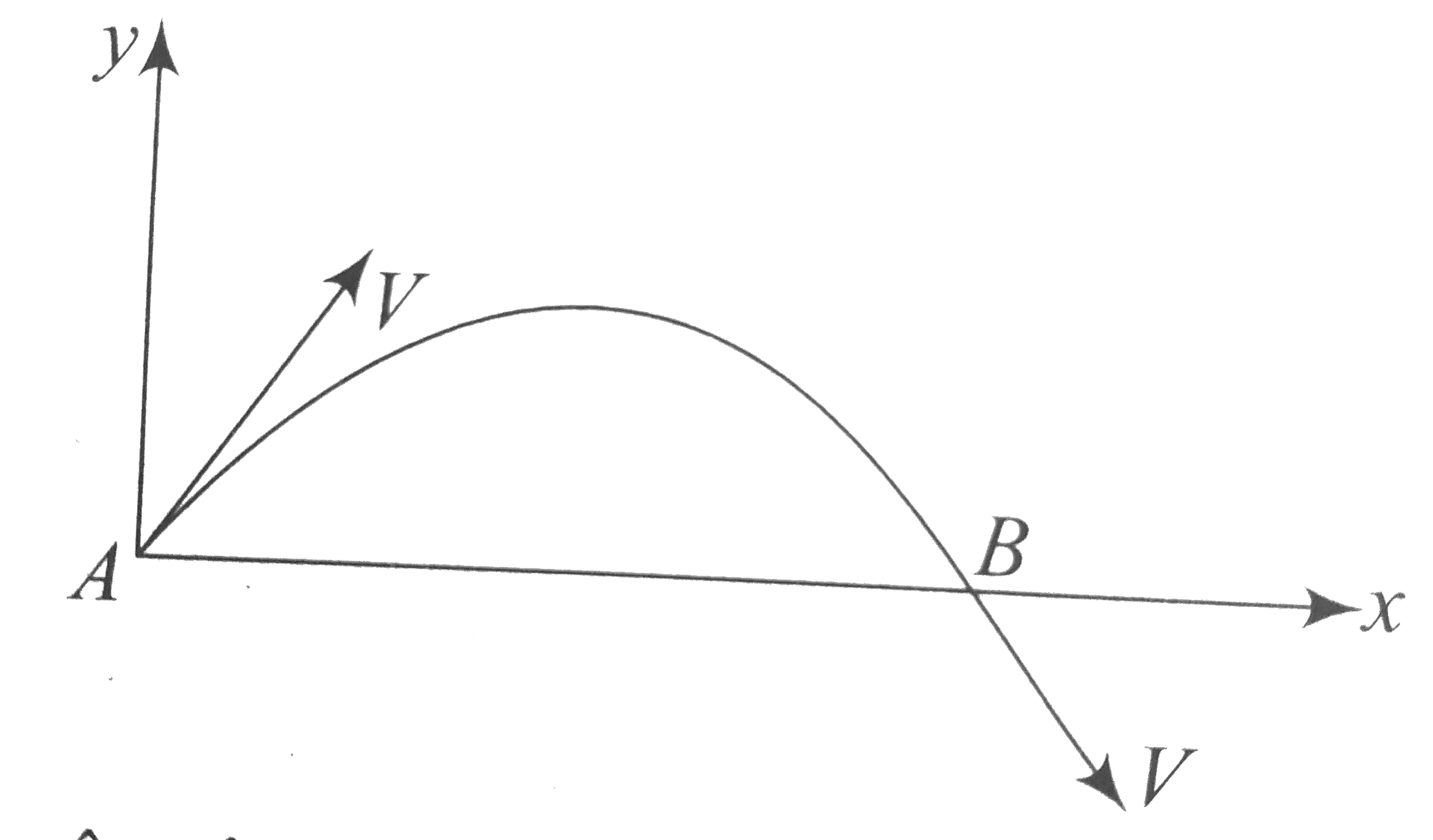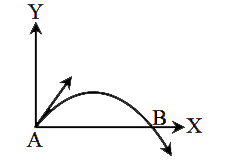Velocity of a projectile at height 15m from ground is v=(20ˆi+10ˆj)m/s. Here ˆi is in horizontal direction and ˆj is vertically upwards. Then
Speed with which particle is projected from ground is……… m/s
30
20√2
√20
3√40
The correct Answer is:B
To find the speed with which the particle is projected from the ground, we can follow these steps:
Step 1: Understand the given information
We are given the velocity of the projectile at a height of 15 m:
v=20^i+10^jm/s
Here, ^i represents the horizontal direction and ^j represents the vertical direction.
Step 2: Identify the components of velocity
From the given velocity:
- The horizontal component of velocity, vx=20m/s
- The vertical component of velocity, vy=10m/s
Step 3: Use the equations of motion
In the vertical direction, the acceleration is due to gravity, which is ay=−g=−10m/s2.
Using the third equation of motion:
v2y=u2y+2ays
Where:
- vy=10m/s (vertical component of velocity at height)
- uy is the initial vertical component of velocity (which we need to find)
- ay=−10m/s2 (acceleration due to gravity)
- s=15m (height)
Step 4: Substitute the values into the equation
Substituting the known values into the equation:
(10)2=u2y+2(−10)(15)
100=u2y−300
u2y=100+300=400
uy=√400=20m/s
Step 5: Find the horizontal component of initial velocity
Since there is no horizontal acceleration, the horizontal component of the initial velocity ux is the same as vx:
ux=vx=20m/s
Step 6: Calculate the initial speed of projection
Now we can find the initial speed u using the Pythagorean theorem:
u=√u2x+u2y
Substituting the values:
u=√(20)2+(20)2=√400+400=√800=20√2m/s
Final Answer
The speed with which the particle is projected from the ground is:
20√2m/s
We are given the velocity of the projectile at a height of 15 m:
v=20^i+10^jm/s
Here, ^i represents the horizontal direction and ^j represents the vertical direction.
From the given velocity:
- The horizontal component of velocity, vx=20m/s
- The vertical component of velocity, vy=10m/s
In the vertical direction, the acceleration is due to gravity, which is ay=−g=−10m/s2.
v2y=u2y+2ays
Where:
- vy=10m/s (vertical component of velocity at height)
- uy is the initial vertical component of velocity (which we need to find)
- ay=−10m/s2 (acceleration due to gravity)
- s=15m (height)
Substituting the known values into the equation:
(10)2=u2y+2(−10)(15)
100=u2y−300
u2y=100+300=400
uy=√400=20m/s
Since there is no horizontal acceleration, the horizontal component of the initial velocity ux is the same as vx:
ux=vx=20m/s
Now we can find the initial speed u using the Pythagorean theorem:
u=√u2x+u2y
Substituting the values:
u=√(20)2+(20)2=√400+400=√800=20√2m/s
The speed with which the particle is projected from the ground is:
20√2m/s
Topper's Solved these Questions
- KINEMATICSBOOK - DC PANDEY ENGLISHCHAPTER - KINEMATICSEXERCISE - MATCH THE COLUMN
3 Videos
- KINEMATICSBOOK - DC PANDEY ENGLISHCHAPTER - KINEMATICSEXERCISE - INTEGER_TYPE
10 Videos
- KINEMATICSBOOK - DC PANDEY ENGLISHCHAPTER - KINEMATICSEXERCISE - MCQ_TYPE
23 Videos
- GRAVITATIONBOOK - DC PANDEY ENGLISHCHAPTER - GRAVITATIONEXERCISE - (C) Chapter Exercises
45 Videos
- KINEMATICS 1BOOK - DC PANDEY ENGLISHCHAPTER - KINEMATICS 1EXERCISE - INTEGER_TYPE
15 Videos
Similar Questions
Velocity of a projectile at height 15m from ground is v=(20ˆi+10ˆj)m/s. Here ˆi is in horizontal direction and ˆj is vertically upwards. Then
Angle of projectile with ground is
View SolutionVelocity of a projectile at height 15m from ground is v=(20ˆi+10ˆj)m/s. Here ˆi is in horizontal direction and ˆj is vertically upwards. Then
Maximum height from a ground is ……..m
View SolutionVelocity of a projectile at height 15m from ground is v=(20ˆi+10ˆj)m/s. Here ˆi is in horizontal direction and ˆj is vertically upwards. Then
Horizontal range of the ground is …………m
View SolutionAssertion At height 20 m from ground , velocity of a projectile is v=(20ˆi+10ˆj)ms−1. Here, ˆi is horizontal and ˆj is vertical. Then, the particle is at the same height after 4s.
Reason Maximum height of particle from ground is 40m (take, g=10ms−2)
View SolutionA particle is projected from gound At a height of 0.4 m from the ground, the velocity of a projective in vector form is →v=(6ˆi+2ˆj)m/s (the x-axis is horizontal and y-axis is vertically upwards). The angle of projection is (g=10m/s2)
View SolutionThe velocity of a projectile at the initial point A is (2ˆi+3ˆj)m/s. Its velocity (in m/s) at point B is

View SolutionThe velocity of a projectile at the initial point A is (2ˆi+3ˆj)ms. It's velocity (in m/s) at point B is -

View SolutionAt a height of 15 m from ground velocity of a projectile is v=(10ˆi+10ˆj). Here ˆj is vertically upwards and ˆi is along horizontal direction then (g = 10 ms−1)
View SolutionVelocity of a particle changes from (3ˆi+4ˆj)m/s to (6ˆi+5ˆj)m/s 2s. Find magnitude and direction of average acceleration.
View SolutionA stone is thrown vertically up at 20 m/s from a tower 80 m height. The speed with which it hits the ground is [g=10m/s2]
View Solution
